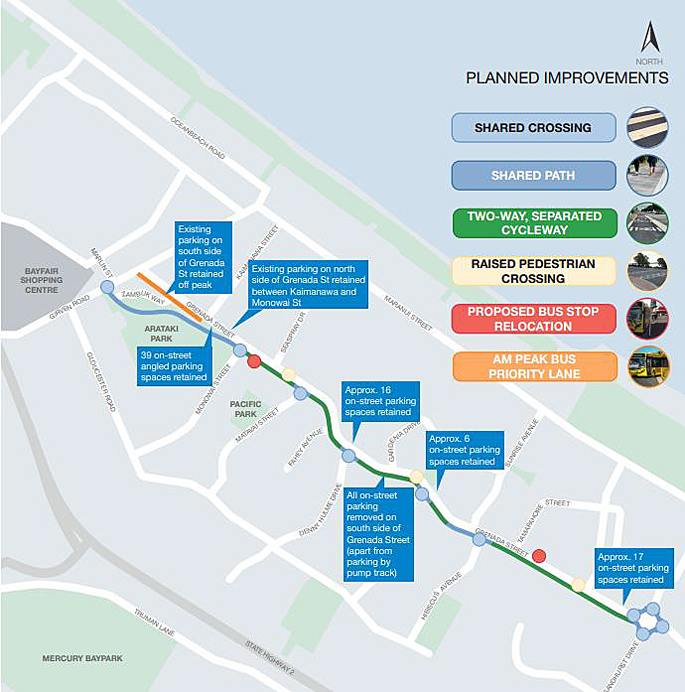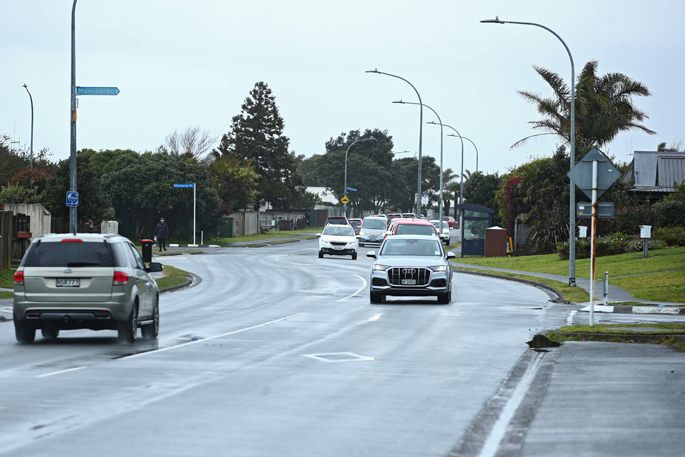Mount Maunganui’s Grenada Street is set to receive a new cycleway as part of a $6.95m upgrade to the road.
The separated two-way 1.7km cycleway will run along the south side of the street from Sandhurst Drive to Monowai Street.
The Transport Choices along Grenada project also includes a new shared path through Arataki Park, a morning peak bus lane between Kaimanawa Street and Girven Road, improved pedestrian crossings and upgraded bus stops.
Waka Kotahi NZ Transport Agency will fund 95 per cent, or $6.6 million, of the project through the Climate Emergency Response Fund Transport Choices initiative. The other $350,000 will be funded by ratepayers through existing Tauranga City Council 2021-2031 long-term plan budgets.
The commissioners agreed to proceed with the project at a council meeting on Monday [SUBS 4/9] and construction will begin in October or November.
The council ran consultation in 2018 and 2019 then again from 19 June to 9 July this year. It included door knocking at homes along Grenada Street, visiting and emailing businesses, two community drop in sessions, flyer and letter drops, and an online survey.
Meetings were also held with school principals from Arataki School and Tahatai School, users of Arataki Park, Pāpāmoa Residents and Ratepayers Association and local hapū.
The council also engaged with “key stakeholders” including cycling groups, Bay of Plenty Regional Council and Hato Hone St John, who have a base on Girven Road.
The feedback received was “significantly more positive than opposed” the community engagement report showed
There were 191 responses to the online survey with 41 per cent fully in support, 23 per cent somewhat in support. The opposition was 15 per cent fully opposed and 17 per cent somewhat opposed, 4 per cent of respondents were neutral.

The changes planned for Grenada Street. Image: Tauranga City Council.
Positive feedback included themes of safety, reduced speeds and increased accessibility of cycling. Some negative feedback included negative sentiment towards construction, loss of parking and opposition to spending money on cycleways.
The cycling community had a mixed response with some commuters saying the design at intersections would result in cyclists using the vehicle lane rather than the cycle lane.
In response to this feedback, council staff looked at whether they could add more on-street but parking but were unable to do so, according to the report.
Commissioners Stephen Selwood and Shadrach Rolleston commended the staff for using door knocking as part of their consultation process.
“I'm particularly pleased with the level of community engagement and consultation, including individual door knocking,” said. Selwood.
“These sort of projects are always challenging because there's a dilemma of meeting the needs of the local community, versus meeting the needs of those who commute through that local community.”
Rolleston agreed: “Actually engaging people's views and feedback on what this means for them [and] trying to accommodate all this within a defined carriage way, whether it's parking, cycleways, you have to compromise something to accommodate active modes [of transport].”

Commissioner Shadrach Rolleston said there needed to be safe access for school students through Arataki. Photo: John Borren/SunLive.
He also wanted to know how the project fitted into the wider transport plan for Arataki and about the provision of safe travel for students to Mount Maunganui Intermediate and Mount Maunganui College.
The schools, with a combined roll of 2400 students, were north of the busy commuter corridor Girven Road
“We do need to provide safe access along these corridors,” said Rolleston.
Council cycle plan implementation team leader Karen Hay said there would be a signalised pedestrian and cycle crossing from Arataki Park across Girven road.
Other roads in the network that were used by school students would be considered as part of the wider Arataki Accessible Streets project, she said.
Accessible Streets is a Waka Kotahi initiative aimed at improving safety for footpath users, encouraging active modes of transport like walking and cycling and encouraging more public transport use.
Waka Kotahi transport choices relationship lead Erica Walker said the project was “absolutely fantastic” from her organisation’s perspective.
“It embodies all the things that we are trying to achieve … it not only delivers a great cycle network, it obviously contributes very heavily to school travel, it also is about connecting communities.”
Construction will start in October or November the council has another round of consultation planned in conjunction with this. The project must be completed by 30 June 2024.
Public Interest Journalism funded through NZ On Air.




3 comments
Impressive
Posted on 07-09-2023 17:58 | By Let's get real
Absolutely the first time that I feel satisfied with any councils assertions about consulting the community. However, How many of those that were consulted actually pay the rates. How many were homeowners, how many were renters and what percentage of those opinions were from residents rather that, like St John, are people who visit the area. I find it interesting, once again, that so few respondents can affect the lives of so many. But at least it was more than the 63 respondents that have imposed a Museum at Gate Pa to be funded by ratepayers whether they want it or not.
About time
Posted on 07-09-2023 18:34 | By Informed
Long overdue. It’s a death trap along here at the moment. My daily ride and you take your life in your hands with the angry boomers who seem more focused on knocking you off your bike than staying in their lane.
Exasperated
Posted on 08-09-2023 09:48 | By Let's get real
We have people like our "informed" contributor, who know the risks of participating in the activities that they choose and still blame everyone else for making their chosen activity life-threatening. The roading networks around the globe were NEVER established for your hobbies. They are there to provide for large motorised vehicles. Even the very earliest tracks were established for horse/oxen carts not for numpties on two wheels who are oblivious to the environment behind them. I like the option to get these mindless mobile hazards off the roads, but I object to having to pay even more taxes for the handful of selfish idiots who want to participate in a hobby that may end their lives and will brutally affect their loved ones. Stay off the road it's not for you and was NEVER designed for you.
Leave a Comment
You must be logged in to make a comment.